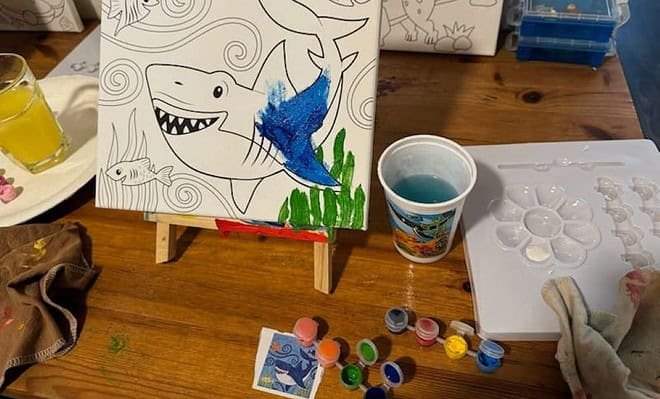We Are Brothers

Mummy has no clue that her first cousin, Kishen Arora, has been residing in San Diego for years. Bhaboji’s (mom’s mother) youngest brother is his father. Over time, his older brothers left India to travel across the continents.
Kishen and his spouse, Bonnie, travel back to the old country. They have been going back and forth through the decades. While on this trip, he informs his relatives of his desire to document the family history. The statement provokes hilarity.
“You wish to be the historian for the Arora clan? Do you grasp how vast our kin is? Can you identify the names of every member?”
Others contribute, too.
“Didn’t you leave India in the early sixties? You were twenty! And over the decades, you’ve made brief appearances.”
He acknowledges the lack of complete knowledge of his relatives. He knows each of his father’s brothers and their families very well. However, he thinks his father has a sister somewhere but does not know where she and her family are. Bhaboji, my grandmother, is the missing sister.
She died at the Nizamuddin place in Delhi eighteen years prior. Our grandfather, Bauji, preceded her in death by twenty years after they had been together for 63 years.
Kishen is eager to explore this new-found arm of the family lineage. The thought of meeting new kinfolks is exciting to Kishen; others may find it more daunting. He visits Bhaboji’s three sons in Nizamuddin, in the house built by Bauji over 50 years ago. He met my cousin, Vijay, who resides in the Great Kailash neighborhood of Delhi.
A brief introduction occurs. Our bond is one of a kind; we are not quite siblings, but we share the same DNA. How is that? Mummy and her older sister, Raj Kumari, married my dad and his older brother, Karam Narain. In my parents’ family, there are three girls and one boy. However, in the other, there are three boys and one girl. Vijay and I are the eldest siblings in our families. Throughout our childhood, we two have a close bond, which our parents also share.
Kishen not only discovers lost relatives, but he also learns of the vacant home in Lahore. He finds out where it is: 9 Beadon Road. His sense of purpose strengthens.
The enigmatic paths, with peculiar twists of fate, guide us humans, and strengthen his aim.
Kishen and Bonnie are active members of a San Diego Rotary Club. They welcome Rotarians from around the globe into their home. Their primary focus has been on supporting and working on projects in South America. Khalid Haider, a Rotarian from Pakistan visiting California, develops a strong connection with the twosome because he shares regional roots with our forefathers. Our ancestors, including our great-grandparents, hail from the Jhang Migiana area in that country. Mummy narrates captivating stories of her childhood summers spent in their havelis (mansions). Bauiji and his brothers inherit these ancestral properties. Bhaboji’s father, Lala Tara Chand, also has a haveli there. He relocates when he becomes the Head Master of Normal School in Lahore. Kishen and Haider Sahib are working together on a grant for a Clean Water Filtration Plant in the nearby Jhang Sadar region.
The Beadon Road discovery fuels Kishen’s longing for a connection to his ancestral land. The momentum of the Filtration Plant Project increases. Locating the Lahorian dwelling is his prime focus; a desire to visit there is still a distant goal. He is driven by an ardent wish to honor our ancestors; he aims to leave a lasting testament by immersing himself in their world.
After their return to the US, they both fly to Chicago the following weekend to connect with my mother. His reason is simple.
“I’m going to meet a sister I’ve never known before.”
Mummy introduces her new brother to Bhaboji, using her khes (handspun and handwoven cotton blanket). She also reveals a valuable heirloom. In 1910, a love-struck Bauji gifts his new wife a charming cuff bracelet. Kishen touches it. A precious, century-old gift, deserves cherishing as a special token of love for a new bride. Mom’s eyes sparkle with delight as she recalls a rumor from back then. The buzz is that the Tahsildar (tax collector) kidnaps a stunning teenager as a partner on one of his forays into the hinterland.
Kishen’s ultimate obsession is locating the house. The house number on Beadon Road has been there for over eighty years (early 1930s). Over time, street names and numbers change, and entire neighborhoods vanish. No matter, it is not a deterrent for Kishen. He forms a bond with a young man, Wasim, from Lahore through the Internet. He tells him of his mission and asks for help to find the building. Two strangers, worlds apart, prepare for a thrilling journey. The Internet has shrunk the world!
Wasim pledges to search the neighborhood and hunt for the structure. Over a few days, he goes door-to-door, sharing his story. Despite multiple setbacks, he is in for the surprise of a lifetime. Upon hearing Bauji’s name, Lala Mela Ram, the family invites him in amidst great excitement.
After a long search, it’s found! He discovers the persons, whose grandfather migrates from India over six decades ago! With joy, they welcome Wasim and recount memories they still cherish of their treacherous journey across the border. They relive a fearsome time. He takes pictures of both the inside and outside of their residence. They want him to deliver a message to Kishen.
“It will be our honor to have you visit your ancestral home in Pakistan.”
The edifice still bears Bhaboji’s name. Large concrete letters spell out “Parkash Bhawan” (Parkash’s residence) on the front outside wall.
They share their thoughts and emotions regarding their home.
“Throughout the years, it has brought us good fortune; a good omen.”
It needs serious repairs after eighty years. However, one thing will stay the same. Our grandmother’s name will always be on it. They provide assurances and reassurances.
Via a dial-up connection to San Diego, Wasim’s pictures find their way to Kishen, halfway around the globe. The young man’s patience, perseverance, and compassion are unbelievable. His belief in this sacred task for a stranger is unwavering.
Vijay and my Mom receive the pictures as well. She points to the window in the middle of the structure, saying, “You entered the world in this room. My doctor was a beautiful woman.”
True to his inimitable style, my prankster cousin drops the photos in front of his uncles, Sri Krishan and Kewal Krishan. Until their teenage years and beyond, they both grew up in that house. A quick glimpse at the pictures and another closer, disbelieving scrutiny, brings them to life. Hours pass as they reminisce without interruptions. Memories gush forth, floodgates open, and the surge is relentless.
It is time to get back to the ancestral research project. Kishen convinces every member of the vast Arora clan to support his proposal to document the family saga. Enthusiasm is evident as everyone records their slice of the epic. They analyze vintage pictures, some over a century old, and share their significance in the family’s ancestry. The receiving duo are working on compiling, gathering, and verifying the narratives coming in. It takes two years to chronicle fourteen generations, covering the period from the 1700s to the 2010s.
Our gracious San Diego hosts follow up by organizing a unique Arora clan reunion at their residence. Over 80 individuals from various countries gather. Mummy and Darshan (Kishen’s aunt from his mom’s side) are the oldest representatives in the US. Their blessings kick off the celebrations. Meals, familial games, analysis of various branches, and forming solid acquaintances last three days. Children entertain with their performances while young men strum guitars. Rishi (our hosts’ youngest) strums and sings a passionate ode to his sister. The festivities get a boost—a city tour with a guide and a picnic lunch in a park. Mummy joyfully unites with the families of her mother’s brothers, people she has only heard of. Feet-touching1 and blessings from the heart galore.
One hundred copies of the scriptural “Our Family History” are given to the attendees. Another 150 copies are for relatives who have been unable to attend the event.
Now that we have connections and reconnections, a trip to Pakistan is possible. The opening ceremony of the Clean Water Plant is coming up. Nephews Pawan and Vijay, along with their wives, Neerja and Geeta, accompany Kishen. They plan to cross the border at Amritsar. Indian authorities question them about their trip to the enemy camp. A mixture of disbelief and amazement at their story results in lengthy hours of interrogation.
Later in the day, after crossing no-man’s-land, they enter Pakistan. Once the authorities grasp their mission, officers from the opposing side desert their desks and embrace them with hugs. “Ignore the politicians,” they recommend. “We are brothers.”
The incredible welcome does not stop there. Haider Sahib and his fellow Rotarians wait all day for both sides to complete the formalities. The delegation receives the visitors and escorts them to a late, lavish meal. Lots of welcome speeches and lauding of Service Above Self ensue.
The Rotary Project is complete, and the Plant is operational. Kishen and Haider Sahib celebrate together, each drinking a glass of clean water together, with interlocking arms.
A tour of the town follows the ceremonies. It’s a must to go to the Gurudwara at Nankana Sahib. Guru Nanak, the first Guru of the Sikh faith, was born there. Visiting a girls’ school is on the agenda. A stopover at the graves of Heer-Ranjha, the Pathan tribes’ equivalent of Romeo and Juliet, is essential. Rotary hosts extravagant dining experiences, including at Haider Sahib’s ancestral home. Despite their efforts, our great-grandfathers’ havelis are not to be found in the city records.
Next destination—Lahore! The historic visit to Bhabhoji’s old dwelling in Lahore is mind-blowing. The entire household is eagerly expecting their arrival. Wasim and his wife are both present. It’s not just them; the entire neighborhood is aware of who is arriving. After 70 years, descendants of the original owners are returning to reconcile and bridge the gap. Welcoming the visitors with open arms, community participants, and business owners fill the vibrant street. Joyfully, they embrace their lost kin. It’s been a long wait. One did not expect it, but the return is happening. The familial home’s doors swing open. All three, Sudhir, Vijay, and I, are born in that house.
The reception is amazing! An individual requests Kishen to visit with him for a few moments. “Please, give me five minutes. Have a cup of tea with my family,” he pleads. My cousin is experiencing a whirlwind of emotions as memories of the home resurface. He remembers setting off Diwali fireworks on the terrace as a five-year-old. Other childhood memories surge and linger.
Our great-grandfather, Lala Tara Chand’s place in Mitti-Putan Gali (street) is also found. Mom recalls visiting there often during her childhood. Back in the day, if one took the nearby street, Pani Wala Talab, leads to a vast meadow behind the dwelling. The meadow is the place where dairy cattle spend their days grazing and wading in the deep pond (Talab). Burgeoning humanity has overtaken the meadow, and it is no longer there. The pond is gone, but the street name still remembers it. Grandfather provides tutoring to his daughter’s high school children. He smokes a clay chillum which he asks Sri Krishan to refresh between lessons. The teenager sneaks in a few puffs while my Mom holds the threat of confessing to Grandpa.
Upon returning to Delhi, Vijay confides in me. “I did not expect to make it back alive. The deceit and enmity perpetuated by politicians are not only wrong but dangerous as well. Our kith and kin extends beyond the border. We are brothers in the truest sense.”
1 In India, it is customary to show respect and seek blessings by touching elders’ feet.
Editor: Claudia Cramer








